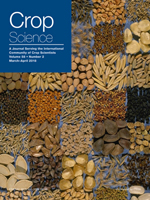Ver ítem
- xmlui.general.dspace_homeCentros Regionales y EEAsCentro Regional CorrientesEEA CorrientesArtículos científicosxmlui.ArtifactBrowser.ItemViewer.trail
- Inicio
- Centros Regionales y EEAs
- Centro Regional Corrientes
- EEA Corrientes
- Artículos científicos
- Ver ítem
Mode of Reproduction and Meiotic Chromosome Behavior in Acroceras macrum
Resumen
Acroceras macrum Stapf is a high-quality C3 grass species adapted to the subtropics. It is a valuable forage resource in frequently flooded environments. The objectives were to analyze the type of polyploidy, mode of reproduction, and estimate seed and pollen fertility. A living collection of 22 tetraploid and five hexaploid genotypes of A. macrum was analyzed. Type of polyploidy was analyzed
from chromosomal pairing at diakinesis and prometaphase I,
[ver mas...]
Acroceras macrum Stapf is a high-quality C3 grass species adapted to the subtropics. It is a valuable forage resource in frequently flooded environments. The objectives were to analyze the type of polyploidy, mode of reproduction, and estimate seed and pollen fertility. A living collection of 22 tetraploid and five hexaploid genotypes of A. macrum was analyzed. Type of polyploidy was analyzed
from chromosomal pairing at diakinesis and prometaphase I, and meiotic irregularities were evaluated during the microsporogenesis. Pollen viability was also examined. Bivalents predominated in tetraploids and trivalents in hexaploids. Meiotic abnormalities were more frequent in hexaploids than in tetraploids, and they were mainly related to mechanisms of chromosome nondisjunction. The reproductive mode was determined by cytological analysis of megasporogenesis and megagametogenesis, seed fertility under different pollination methods, and molecular progeny tests. In both tetraploid and hexaploid races, only the development of single meiotically derived embryo sacs was observed. Greater seed production in outcrossing compared with selfing indicated a primarily
allogamous matting system. Progenies from crosses between genetically different tetraploid genotypes amplified male-specific molecular markers, indicating a hybrid origin and solid evidence of sexual reproduction. Population breeding approaches developed for sexual cross-pollinated species are suited for improving A. macrum.
[Cerrar]

Autor
Ferrari Usandizaga, Silvana Consuelo;
Martínez, Eric Javier;
Schedler, Mara;
Honfi, Ana I.;
Acuña, Carlos Alberto;
Fuente
Crop Science : 1-22 (January 2020)
Fecha
2020-01
Editorial
Wiley
ISSN
0011-183X
1435-0653
1435-0653
Formato
pdf
Tipo de documento
artículo
Palabras Claves
Derechos de acceso
Embargado
 Excepto donde se diga explicitamente, este item se publica bajo la siguiente descripción: Creative Commons Attribution-NonCommercial-ShareAlike 2.5 Unported (CC BY-NC-SA 2.5)
Excepto donde se diga explicitamente, este item se publica bajo la siguiente descripción: Creative Commons Attribution-NonCommercial-ShareAlike 2.5 Unported (CC BY-NC-SA 2.5)

